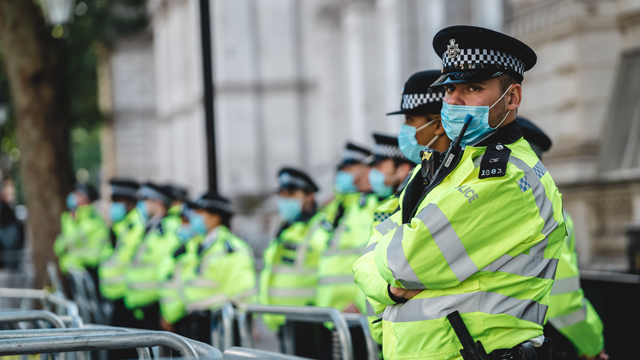
COVID small grant recipients announced
The N8 Policing Research Partnership is delighted to announce the funding of four COVID Small Grant projects, as part of our effort to support research into the COVID-19 pandemic.
These projects are in addition to the two funded projects from our 5th round of annual Small Grants and will commence work alongside them. As ever with our Small Grants, we received a fantastic number of applications and it proved extremely difficult deciding which ones to fund. After hearing feedback from an external panel and also from the N8 PRP Steering Group, a decision was made to fund the following four projects:
(1) PROTECT COVID 19: Exploring lived experiences of the impact of intimate partner violence and abuse on children, affected family members and perpetrators during the COVID- 19 global pandemic.
Team
- Lead Organisation: Newcastle University
- Morpeth, Cumbria, Northumberland, Tyne and Wear NHS Foundation Trust and Newcastle University
- Northumbria University
- Tees Esk and Wear Valleys NHS Foundation Trust and County Durham and Darlington NHS Foundation Trust
- Durham Constabulary
- Gateshead Local Authority
Summary
In 2019, approximately 2.4 million adults (16-74 years) experienced intimate partner violence and abuse (IPVA) in England and Wales (2). The COVID-19 pandemic lockdown may have exacerbated IPVA as a surge in incidents has been reported through local police intelligence and calls to UK helplines (3). Causal factors may include loss of income and associated stress alongside the disruption of social and protective networks especially for women over 50 and BME groups and the decreased access to support services (7). This impact is felt most greatly within the home and may reverberate across family networks. The additional factor of school closures may increase tension whilst also resulting in children being exposed to parental IPVA or familial abuse at a higher and more significant rate than usual and reduced opportunity for contact with services who may otherwise identify this (3). In addition, a recent Social Care Institute for Excellence report emphasises that as lockdown eases, perpetrators of IPVA may try to re-exert control they perceive they have had during lockdown by engaging in new and/or more harmful behaviour and intensifying coercive control (10).
Vision: Our proposed N8 project has emerged out of an on-going and existing research project with practitioners into parental IPVA, which has identified a changed multi-agency response to parents who have been affected by IPVA during lockdown. These practitioners reported that they have been attempting to support parents to stay safe within the abusive and violent relationship. This is a substantial shift in practice, which previously typically assisted victims to exit abusive relationships. However, the current pandemic context results in alternative accommodation, such as hotels, being deemed to be ‘unsafe’ or unsuitable to women and their children fleeing IPVA due to the risks associated with the behaviour of other vulnerable adults within these accommodations (such as homeless and substance using males), the potential for infection with COVID 19 whilst residing in shared spaces and due to staffing shortages due to illness and shielding. Thus, there is an urgent need to understand how victims and survivors of parental IPVA have experienced the changed multi-agency response to IPVA during the pandemic and their evolving needs within this fast-changing context.
(2) Understanding changing demand for police during the Coronavirus pandemic
Team
- University of Manchester (lead partner)
- Cheshire Constabulary
- University College London
Summary
COVID-19 has created unprecedented challenges for policing in the UK and globally, both by creating new tasks (e.g. enforcing government restrictions or shielding vulnerable staff), and by shifting patterns in demand resulting from changes in people’s routine activities. There has been some work both in-house and academic, looking at some of these shifts, however these either focus only on crimes, and/or calculate changes by comparing the time period in question to the same time last year, a technique which can provide incorrect and misleading results (Ratcliffe, 2017; Ashby 2020).
In this project we propose to explore using a mixed-method approach of robust time-series analysis and interviews to explore changes in non-crime demand during the different stages of lockdown. Since only a minority of calls for service result in a crime being recorded, focusing on crime ignores the vast amount of police time spent on demand such as mental health incidents, anti-social behaviour, missing people and traffic collisions. These calls are particularly important because they relate to protecting vulnerable people, who may have been disproportionately affected by the pandemic (e.g. by the suspension of some services). Focusing on these types of demand therefore reflect changes to a key element of the role of police to protect vulnerable people during lockdown.
To achieve this, we answer the following research questions:
- How has non-crime demand changed in (a) volume (b) location, and (c) time of calls?
- How has the nature of calls and how they were addressed changed?
- In cases where demand increased/decreased where did the demand go/ where did it come from?
- What is the context around these changes?
Our research design is two-stage. First to answer questions about changes in demand, we will use calls for service data to identify changes in calls broken down by call type, time of day (police shift) type of neighbourhood (e.g. land use, census demographics, deprivation measures), route of the call (eg 101 or 999 or Single Online Home reporting), and changes in response (e.g. response times). To improve on the problems of year-to-date comparisons we will use seasonal autoregressive integrated moving average (SARIMA) models to make predictions from historic data on what would have happened in the absence of the pandemic while accounting for overall trends, noise, and other patterns (Ashby 2020a). Second, we will conduct interviews with staff in the Force Contact Centre for Cheshire Constabulary, to generate hypotheses about the contexts around these changes, enriching understanding around the possible mechanisms behind these changes. By considering in-depth the changes in demand, we will generate hypotheses about where the demand came from, how profiles of callers changed, how the method in which calls were raised altered, and how these affect the expectations of the public on the way their calls were handled and responded to.
We generate added value in three ways. First, understanding how police demand changed at each stage of the pandemic will assist in planning for potential future waves of the virus. Having a better understanding of changes in demand may also assist forces in minimising short-notice changes to officers’ duties, minimising disruption both to planned police activities (e.g. training) and officers’ home lives (an important factor in officer wellbeing). It may also help identify needs to work with other agencies. Second, we will provide training by collaborating with the UK Data Service/ Methods@manchester to host a webinar open to all policing partners to provide training on the analytical methods we use to help build in-house expertise for forces to carry out more reliable times-series forecasting analyses. Thirdly, by generating hypotheses about the nature and context of changing demand, we open the door to further research. Our results will pave way for a larger scale collaborative research project with other (policing and external) partners, to pursue the themes which emerge from this work, and increase the depth and breadth of understanding around changing demands around protecting vulnerable people in the pandemic and beyond.
(3) Every ticket is a story: Piloting a “whole story” approach to understanding ethnic disproportionality in FPNs issued for breaching coronavirus restrictions
Team
- University of Liverpool (Lead Partner)
- West Yorkshire Police
- Cumbria Police
- Cheshire Police
- Greater Manchester Police
Summary
Between 27 March and 25 May 2020 the overall rate at which FPNs for breaches of coronavirus regulations were issued was 1.8 times higher for Black and Asian people than it was for White people. The proposed project will develop and test a “telling the whole story” approach to exploring the ethnic disproportionality in coronavirus FPNs. This approach seeks to situate the blunt and imperfect tool of quantitative measurement of disproportionality against the backdrop of wider social divisions and inequalities, and the sharper insights available through the use of richer qualitative data on police-public encounters and the crucial contextual factors that shape each encounter.
The approach will entail close collaboration between academics and police analysts to identify opportunities to exploit as fully as possible the potential of existing police datasets and records, and to explore available data on the wider contextual factors relevant to the issue of BAME disproportionality (including for example wider socio-economic indicators and data on calls for service in relation to coronavirus regulation breaches). This quantitatively-oriented work will be complemented by the production and analysis of a qualitative dataset of interviews with officers involved in a sample of the cases where FPNS for breaches of the health protection regulations were issued. The training implications of any findings from the research will be explored and potential applications developed in collaboration with force training departments to ensure the training undertaken is more evidence-based.
By adopting this approach in relation to issues associated with the current pandemic this project will seek to provide timely input to an urgent issue as there is growing scrutiny of the police in this area. This includes the recent publication of an NPCC Report on disproportionality around Fixed Penalty Notice ticketing, the proposal for a thematic HMICFRS COVID-19 inspection including policing practices in the enforcement of regulations during the pandemic and the announcement from the IOPC around a thematic focus on race discrimination investigations. In addition supplementary, COVID related evidence (in particular the disproportionality around use of Enforcement) was discussed in the Home Affairs Select Committee ‘The MacPherson Report: twenty-one years on’. If the police are perceived to be treating different groups unfairly this may undermine their capacity to engage constructively with those groups to limit the spread of the disease. As such, enhancing understanding in this area will enable forces to identify opportunities to improve their approach to engagement around the measures in place to limit coronavirus transmission, particularly amongst BAME communities that are known to be more vulnerable to the disease.
The project will also lay the foundations for a longer-term collaboration between the participating police forces and academics to develop, apply and pilot a new approach to understanding and addressing the longstanding ethnic disproportionality in the use of all police powers, including stop and search and use of force. Available data have long indicated that police powers are used more frequently against people from BAME backgrounds than might be expected given their representation in the population. This disproportionality has proven to be an intractable issue with significant implications both in terms of community cohesion and in terms of BAME confidence in the police, which may also be linked to lower levels of representation in the workforce. By exploring the potential for more holistic and qualitative approaches to enrich understanding and support positive change this project has the potential for significant and timely impact in the current climate.
(4) Policing domestic abuse during COVID-19
Team
- South Yorkshire Police (Lead partner)
- Sheffield Hallam University
- University of Liverpool
Summary
The project aims to explore policing domestic abuse (DA) within the context of the Covid-19 lockdown when victims were confined to their homes and therefore potentially at greater risk of experiencing DA and less likely to have the freedom to report it safely. Additionally, the project aims to assess the impact of three initiatives launched during the lockdown period. One initiative, an online reporting tool (ORT), was specifically developed by South Yorkshire Police (SYP) to support victims in reporting DA safely and silently during Covid-19. Two other projects, Scene Attenders (SA; supporting victims to press charges) and Smart Water Forensic Marking (SW; forensic marking of the victims’ property that ‘marks’ the offender if they visit the victim, thus providing a layer of safety/security for the victim), although developed prior to Covid-19, were launched during the lockdown period to provide extra levels of support at this critical point.
Silent reporting (through the ORT) is a novel area in policing with little known of how victims might engage or benefit from it. The ORT strand of research will compare reporting characteristics of victims and incidents pre-, during and post-lockdown logged with SYP. This research will impact on SYP’s policy and planning in their development of DA silent reporting tools (e.g., continuation of the ORT and development of web-chat reporting). It will also have a positive impact on future victims who will benefit from reduced reporting risks from the development of appropriate silent reporting mechanisms.
Exploring the victim experience during lockdown is important, particularly if further lockdowns occur, and allows an understanding of the policing needed to support vulnerable/isolated victims. The qualitative strands of this research will explore the ‘journey’ of DA victims during Covid-19 from initial report, to pressing charges, and their experiences in the immediate days/weeks after reporting. This research will further compare the perceptions and experience of victims reporting to SYP and another ‘control’ police force (possibly West Yorkshire Police or Thames Valley Police) to help measure the impact of the three initiatives. The victims’ experiences will inform understandings around reporting method choices, and whether SAs provide support to press charges or instead add pressure during a time of vulnerability. Further, SAs and SW comparisons between forces allow understanding of the efficacy of victim-centred support to inform future practice and resource allocation decisions.
Comparisons between offenders reported to SYP and the ‘control’ police force will be explored to understand how and why SW may prevent offender contact with victims to help determine whether SW is mere placebo for the victim, or if real impacts on offender behaviour are occurring in response to SW. It is important to explore mechanisms to reduce offender contact with victims, particularly during Covid-19 when offenders know exactly where they could locate the victim. The results will also inform both future research collaborations as well as policing practice, for example, SW has the potential to be included as an effective policing tactic when the DA Protection Orders (DAPO) are launched and could also potentially inform the prohibitions/conditions of the new DAPOs.
This project will require academic and policing partners to co-create three related studies, generate materials, select participant samples, conduct interviews, and develop an analytic strategy. We will collate reporting data from both forces (pre, during and post) and examine the demographic, crime, and procedural characteristics. This analysis will inform the sampling strategy, allowing stratification of participant selection (both victim and offender). Continual consideration is needed during the study to ensure that data collection is consistent with guidance relating to social distancing.









0 Comments